AUD/USD Exchange Rate Analysis and Policy Recommendations
VerifiedAdded on 2021/04/16
|8
|1226
|59
AI Summary
The assignment explores the dynamics of the AUD/USD exchange rate, examines the impact of interest rates and export earnings on currency value, and proposes strategies for the Reserve Bank of Australia to boost the currency's strength. It also discusses potential drawbacks of these policies, including reduced economic growth and increased export costs.
Contribute Materials
Your contribution can guide someone’s learning journey. Share your
documents today.
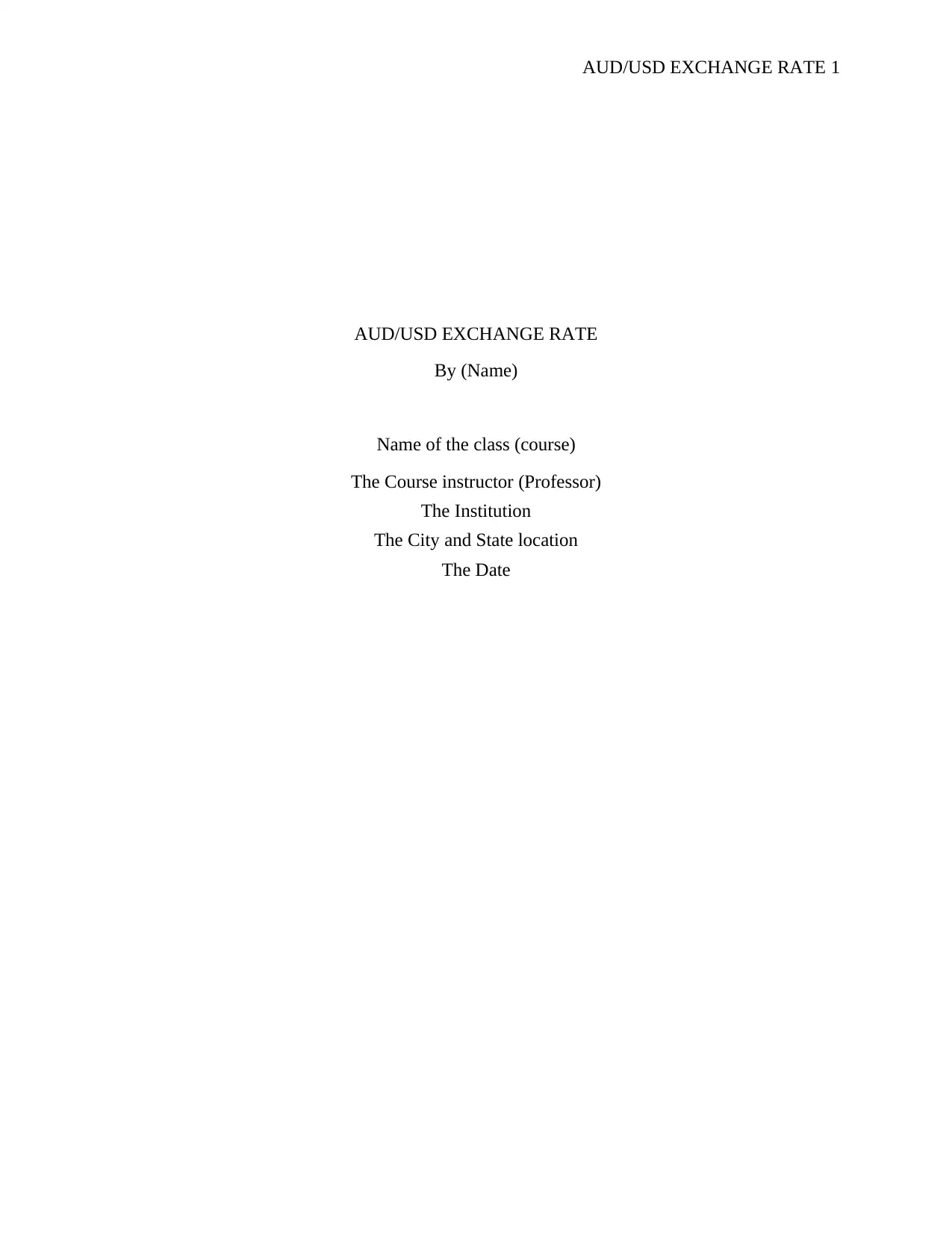
AUD/USD EXCHANGE RATE 1
AUD/USD EXCHANGE RATE
By (Name)
Name of the class (course)
The Course instructor (Professor)
The Institution
The City and State location
The Date
AUD/USD EXCHANGE RATE
By (Name)
Name of the class (course)
The Course instructor (Professor)
The Institution
The City and State location
The Date
Secure Best Marks with AI Grader
Need help grading? Try our AI Grader for instant feedback on your assignments.
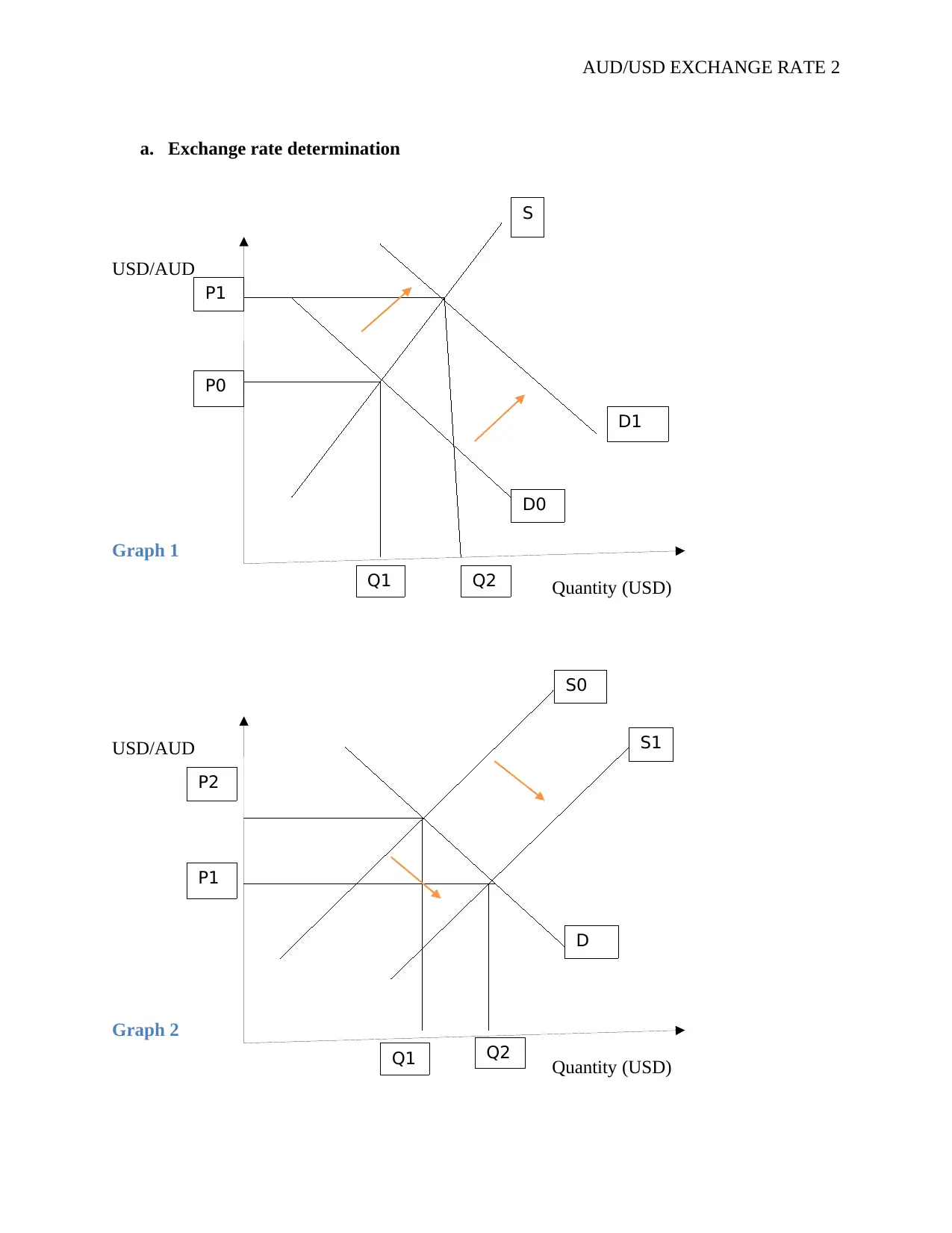
AUD/USD EXCHANGE RATE 2
a. Exchange rate determination
USD/AUD
Graph 1
Quantity (USD)
USD/AUD
Graph 2
Quantity (USD)
S0
S1
D
Q1 Q2
P1
P2
S
D0
D1
Q1 Q2
P0
P1
a. Exchange rate determination
USD/AUD
Graph 1
Quantity (USD)
USD/AUD
Graph 2
Quantity (USD)
S0
S1
D
Q1 Q2
P1
P2
S
D0
D1
Q1 Q2
P0
P1
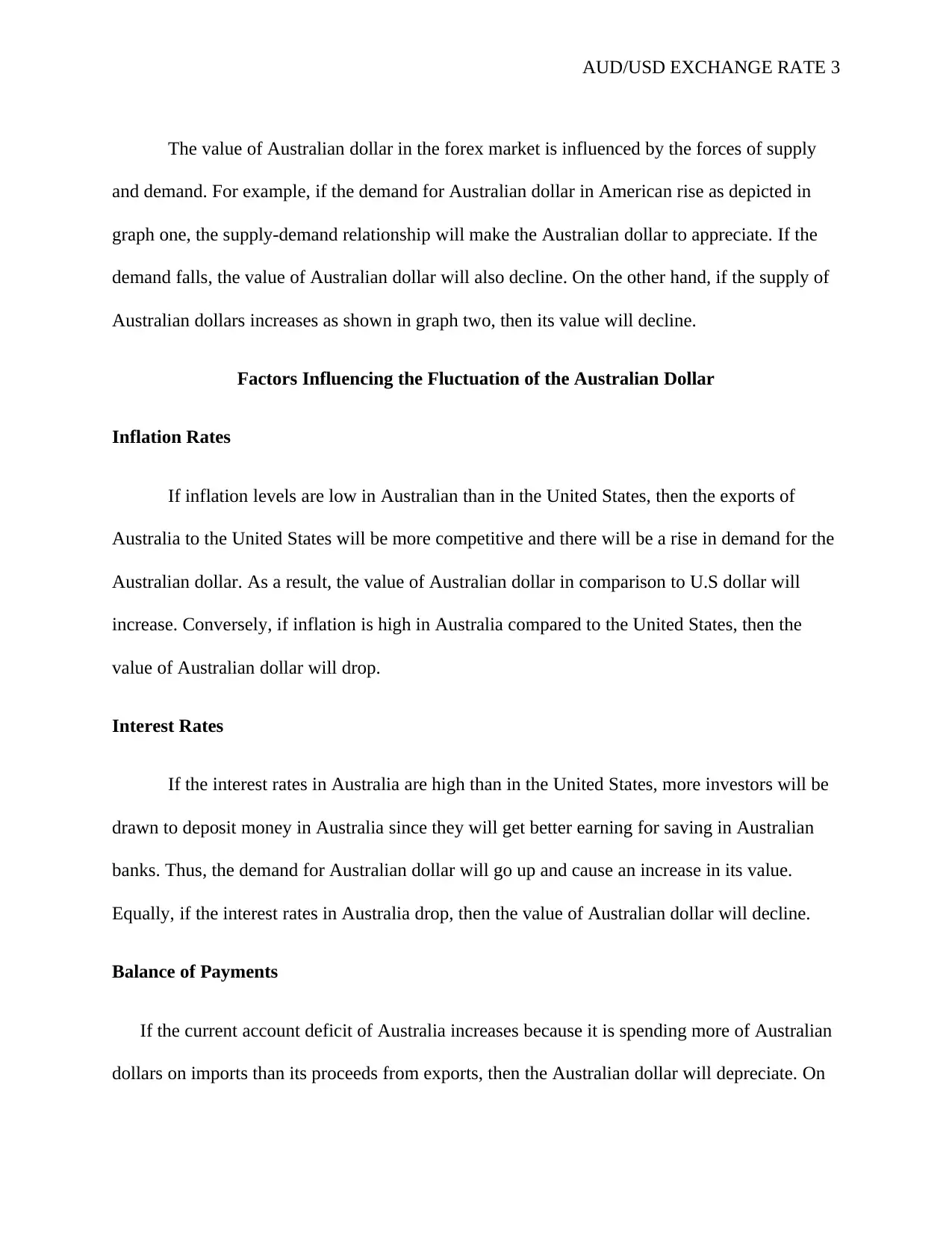
AUD/USD EXCHANGE RATE 3
The value of Australian dollar in the forex market is influenced by the forces of supply
and demand. For example, if the demand for Australian dollar in American rise as depicted in
graph one, the supply-demand relationship will make the Australian dollar to appreciate. If the
demand falls, the value of Australian dollar will also decline. On the other hand, if the supply of
Australian dollars increases as shown in graph two, then its value will decline.
Factors Influencing the Fluctuation of the Australian Dollar
Inflation Rates
If inflation levels are low in Australian than in the United States, then the exports of
Australia to the United States will be more competitive and there will be a rise in demand for the
Australian dollar. As a result, the value of Australian dollar in comparison to U.S dollar will
increase. Conversely, if inflation is high in Australia compared to the United States, then the
value of Australian dollar will drop.
Interest Rates
If the interest rates in Australia are high than in the United States, more investors will be
drawn to deposit money in Australia since they will get better earning for saving in Australian
banks. Thus, the demand for Australian dollar will go up and cause an increase in its value.
Equally, if the interest rates in Australia drop, then the value of Australian dollar will decline.
Balance of Payments
If the current account deficit of Australia increases because it is spending more of Australian
dollars on imports than its proceeds from exports, then the Australian dollar will depreciate. On
The value of Australian dollar in the forex market is influenced by the forces of supply
and demand. For example, if the demand for Australian dollar in American rise as depicted in
graph one, the supply-demand relationship will make the Australian dollar to appreciate. If the
demand falls, the value of Australian dollar will also decline. On the other hand, if the supply of
Australian dollars increases as shown in graph two, then its value will decline.
Factors Influencing the Fluctuation of the Australian Dollar
Inflation Rates
If inflation levels are low in Australian than in the United States, then the exports of
Australia to the United States will be more competitive and there will be a rise in demand for the
Australian dollar. As a result, the value of Australian dollar in comparison to U.S dollar will
increase. Conversely, if inflation is high in Australia compared to the United States, then the
value of Australian dollar will drop.
Interest Rates
If the interest rates in Australia are high than in the United States, more investors will be
drawn to deposit money in Australia since they will get better earning for saving in Australian
banks. Thus, the demand for Australian dollar will go up and cause an increase in its value.
Equally, if the interest rates in Australia drop, then the value of Australian dollar will decline.
Balance of Payments
If the current account deficit of Australia increases because it is spending more of Australian
dollars on imports than its proceeds from exports, then the Australian dollar will depreciate. On
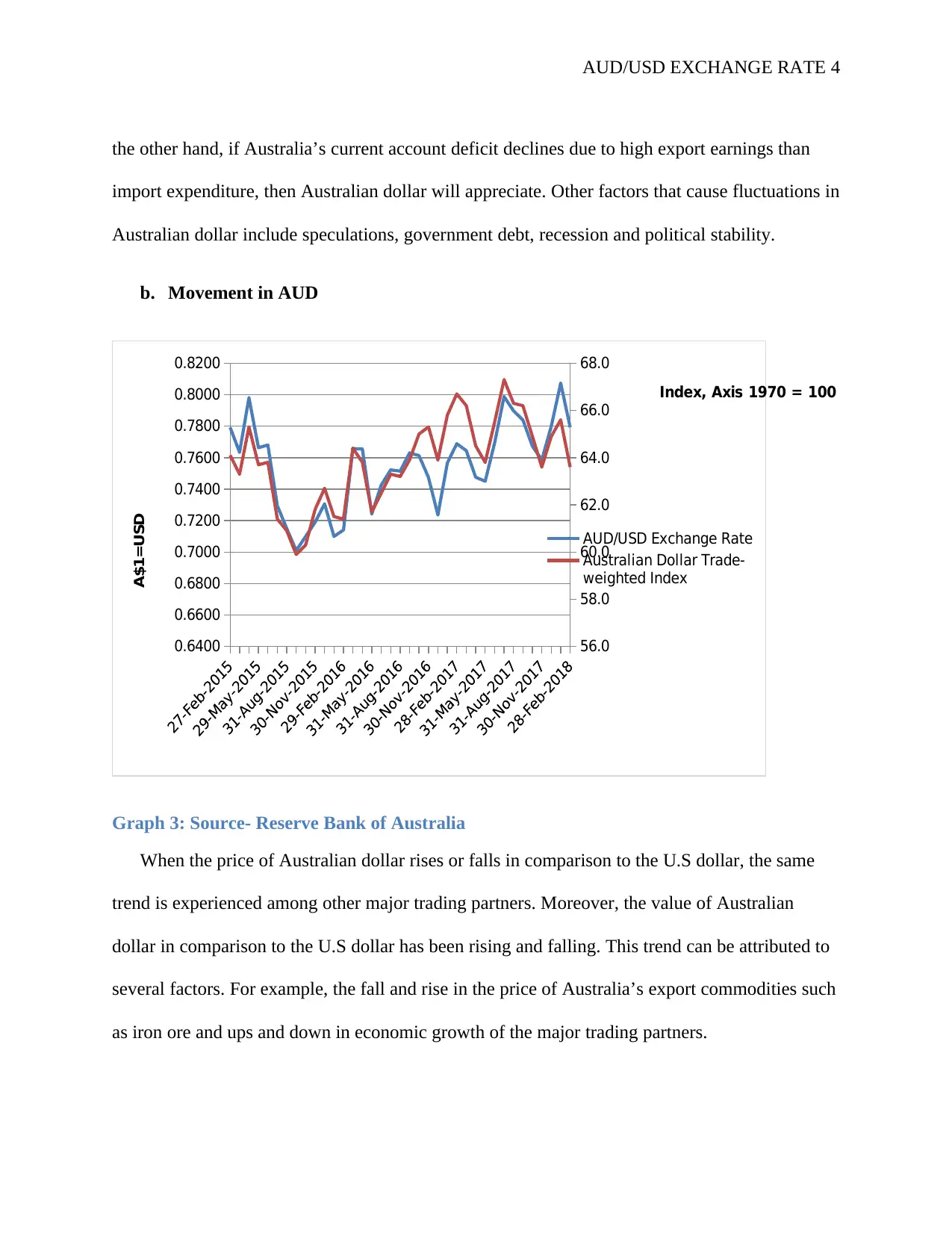
AUD/USD EXCHANGE RATE 4
the other hand, if Australia’s current account deficit declines due to high export earnings than
import expenditure, then Australian dollar will appreciate. Other factors that cause fluctuations in
Australian dollar include speculations, government debt, recession and political stability.
b. Movement in AUD
0.6400
0.6600
0.6800
0.7000
0.7200
0.7400
0.7600
0.7800
0.8000
0.8200
56.0
58.0
60.0
62.0
64.0
66.0
68.0
AUD/USD Exchange Rate
Australian Dollar Trade-
weighted Index
A$1=USD
Index, Axis 1970 = 100
Graph 3: Source- Reserve Bank of Australia
When the price of Australian dollar rises or falls in comparison to the U.S dollar, the same
trend is experienced among other major trading partners. Moreover, the value of Australian
dollar in comparison to the U.S dollar has been rising and falling. This trend can be attributed to
several factors. For example, the fall and rise in the price of Australia’s export commodities such
as iron ore and ups and down in economic growth of the major trading partners.
the other hand, if Australia’s current account deficit declines due to high export earnings than
import expenditure, then Australian dollar will appreciate. Other factors that cause fluctuations in
Australian dollar include speculations, government debt, recession and political stability.
b. Movement in AUD
0.6400
0.6600
0.6800
0.7000
0.7200
0.7400
0.7600
0.7800
0.8000
0.8200
56.0
58.0
60.0
62.0
64.0
66.0
68.0
AUD/USD Exchange Rate
Australian Dollar Trade-
weighted Index
A$1=USD
Index, Axis 1970 = 100
Graph 3: Source- Reserve Bank of Australia
When the price of Australian dollar rises or falls in comparison to the U.S dollar, the same
trend is experienced among other major trading partners. Moreover, the value of Australian
dollar in comparison to the U.S dollar has been rising and falling. This trend can be attributed to
several factors. For example, the fall and rise in the price of Australia’s export commodities such
as iron ore and ups and down in economic growth of the major trading partners.
Secure Best Marks with AI Grader
Need help grading? Try our AI Grader for instant feedback on your assignments.
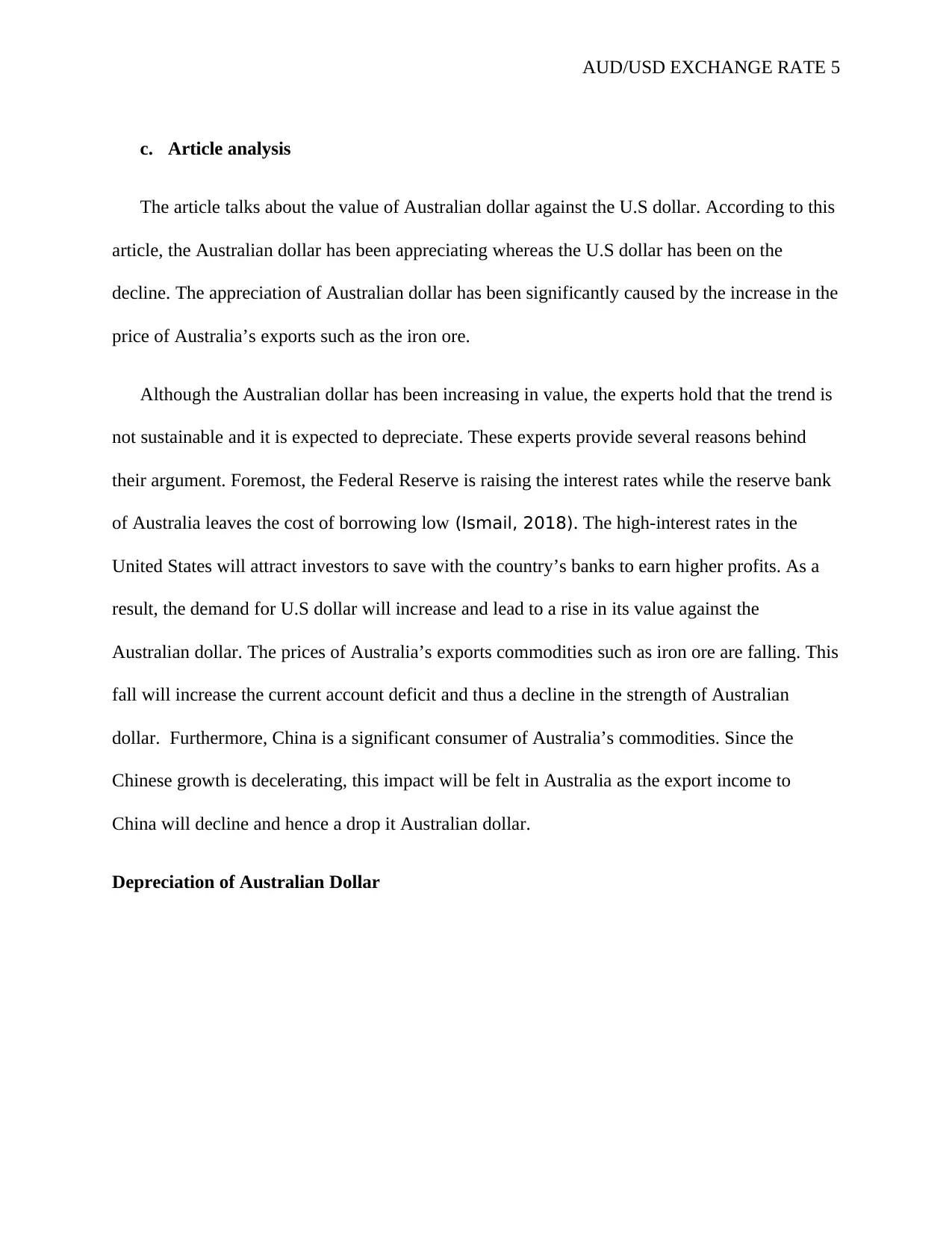
AUD/USD EXCHANGE RATE 5
c. Article analysis
The article talks about the value of Australian dollar against the U.S dollar. According to this
article, the Australian dollar has been appreciating whereas the U.S dollar has been on the
decline. The appreciation of Australian dollar has been significantly caused by the increase in the
price of Australia’s exports such as the iron ore.
Although the Australian dollar has been increasing in value, the experts hold that the trend is
not sustainable and it is expected to depreciate. These experts provide several reasons behind
their argument. Foremost, the Federal Reserve is raising the interest rates while the reserve bank
of Australia leaves the cost of borrowing low (Ismail, 2018). The high-interest rates in the
United States will attract investors to save with the country’s banks to earn higher profits. As a
result, the demand for U.S dollar will increase and lead to a rise in its value against the
Australian dollar. The prices of Australia’s exports commodities such as iron ore are falling. This
fall will increase the current account deficit and thus a decline in the strength of Australian
dollar. Furthermore, China is a significant consumer of Australia’s commodities. Since the
Chinese growth is decelerating, this impact will be felt in Australia as the export income to
China will decline and hence a drop it Australian dollar.
Depreciation of Australian Dollar
c. Article analysis
The article talks about the value of Australian dollar against the U.S dollar. According to this
article, the Australian dollar has been appreciating whereas the U.S dollar has been on the
decline. The appreciation of Australian dollar has been significantly caused by the increase in the
price of Australia’s exports such as the iron ore.
Although the Australian dollar has been increasing in value, the experts hold that the trend is
not sustainable and it is expected to depreciate. These experts provide several reasons behind
their argument. Foremost, the Federal Reserve is raising the interest rates while the reserve bank
of Australia leaves the cost of borrowing low (Ismail, 2018). The high-interest rates in the
United States will attract investors to save with the country’s banks to earn higher profits. As a
result, the demand for U.S dollar will increase and lead to a rise in its value against the
Australian dollar. The prices of Australia’s exports commodities such as iron ore are falling. This
fall will increase the current account deficit and thus a decline in the strength of Australian
dollar. Furthermore, China is a significant consumer of Australia’s commodities. Since the
Chinese growth is decelerating, this impact will be felt in Australia as the export income to
China will decline and hence a drop it Australian dollar.
Depreciation of Australian Dollar

AUD/USD EXCHANGE RATE 6
USD/AUD
Graph 4
Quantity (USD)
Australia’s low-interest rate in comparison to U.S interest rate and the decline in
Australia’s exports earnings due to the falling prices of iron ore will result in the decline in
demand for Australian dollars. This drop is depicted in graph three by the shift in demand curve
from D1 to D0. As a result, the value of Australian dollar will decline from P1 to P0.
d. Impact of AUD Depreciation on Firms
The depreciation of Australian dollar in comparison to the U.S dollar will be detrimental to
my firm that imports electrical machinery from the United States. This is because my company
will use more Australian dollars to purchase U.S dollar in order to facilitate the purchase of
goods. While Australian importers will lose, the Australian exporters will benefit from the
depreciation of the country’s currency because their exports in the United States will cheap and
hence they will sell more products.
e. Increasing the Value Of the Australian Dollar
S
D0
D1
Q1 Q2
P0
P1
USD/AUD
Graph 4
Quantity (USD)
Australia’s low-interest rate in comparison to U.S interest rate and the decline in
Australia’s exports earnings due to the falling prices of iron ore will result in the decline in
demand for Australian dollars. This drop is depicted in graph three by the shift in demand curve
from D1 to D0. As a result, the value of Australian dollar will decline from P1 to P0.
d. Impact of AUD Depreciation on Firms
The depreciation of Australian dollar in comparison to the U.S dollar will be detrimental to
my firm that imports electrical machinery from the United States. This is because my company
will use more Australian dollars to purchase U.S dollar in order to facilitate the purchase of
goods. While Australian importers will lose, the Australian exporters will benefit from the
depreciation of the country’s currency because their exports in the United States will cheap and
hence they will sell more products.
e. Increasing the Value Of the Australian Dollar
S
D0
D1
Q1 Q2
P0
P1
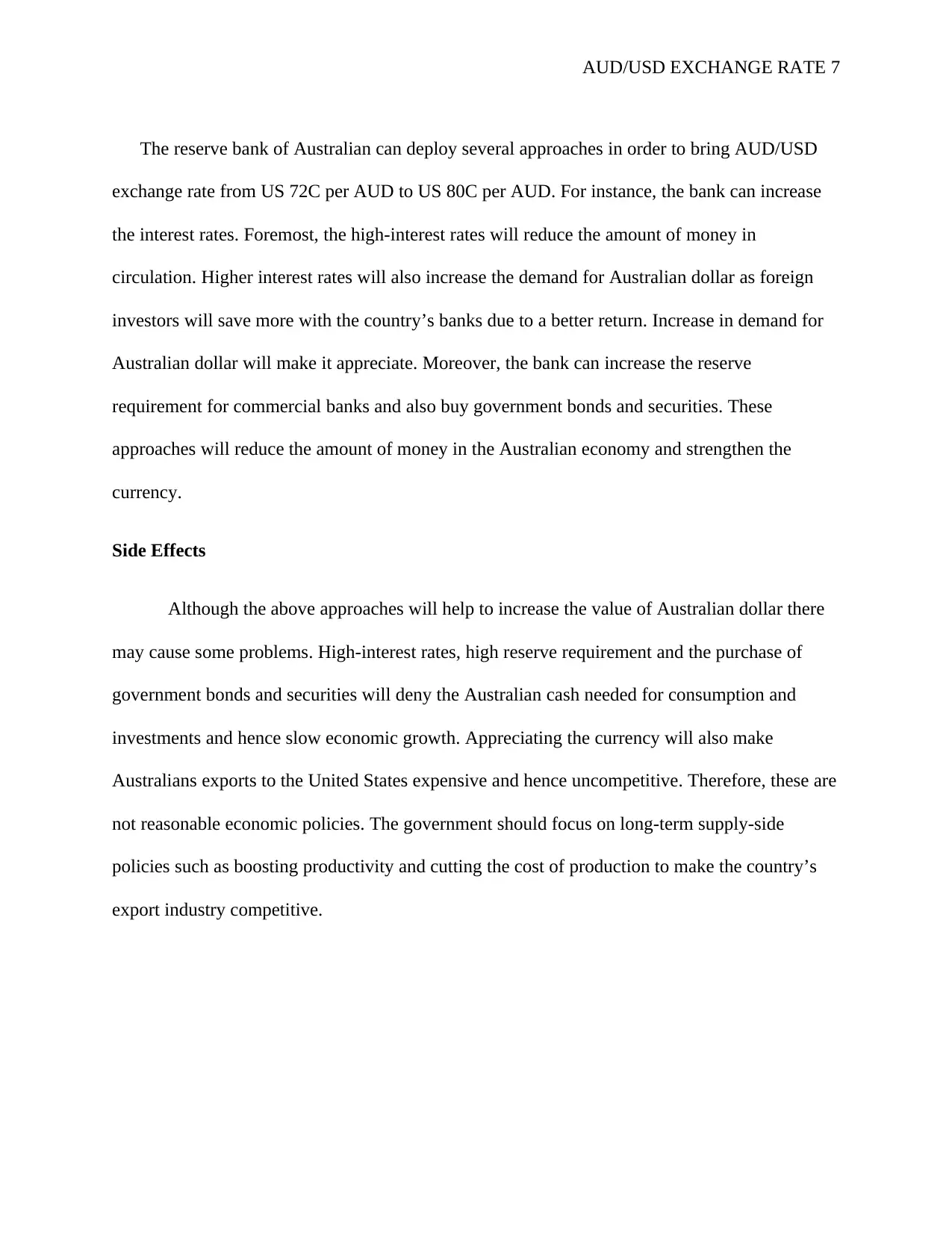
AUD/USD EXCHANGE RATE 7
The reserve bank of Australian can deploy several approaches in order to bring AUD/USD
exchange rate from US 72C per AUD to US 80C per AUD. For instance, the bank can increase
the interest rates. Foremost, the high-interest rates will reduce the amount of money in
circulation. Higher interest rates will also increase the demand for Australian dollar as foreign
investors will save more with the country’s banks due to a better return. Increase in demand for
Australian dollar will make it appreciate. Moreover, the bank can increase the reserve
requirement for commercial banks and also buy government bonds and securities. These
approaches will reduce the amount of money in the Australian economy and strengthen the
currency.
Side Effects
Although the above approaches will help to increase the value of Australian dollar there
may cause some problems. High-interest rates, high reserve requirement and the purchase of
government bonds and securities will deny the Australian cash needed for consumption and
investments and hence slow economic growth. Appreciating the currency will also make
Australians exports to the United States expensive and hence uncompetitive. Therefore, these are
not reasonable economic policies. The government should focus on long-term supply-side
policies such as boosting productivity and cutting the cost of production to make the country’s
export industry competitive.
The reserve bank of Australian can deploy several approaches in order to bring AUD/USD
exchange rate from US 72C per AUD to US 80C per AUD. For instance, the bank can increase
the interest rates. Foremost, the high-interest rates will reduce the amount of money in
circulation. Higher interest rates will also increase the demand for Australian dollar as foreign
investors will save more with the country’s banks due to a better return. Increase in demand for
Australian dollar will make it appreciate. Moreover, the bank can increase the reserve
requirement for commercial banks and also buy government bonds and securities. These
approaches will reduce the amount of money in the Australian economy and strengthen the
currency.
Side Effects
Although the above approaches will help to increase the value of Australian dollar there
may cause some problems. High-interest rates, high reserve requirement and the purchase of
government bonds and securities will deny the Australian cash needed for consumption and
investments and hence slow economic growth. Appreciating the currency will also make
Australians exports to the United States expensive and hence uncompetitive. Therefore, these are
not reasonable economic policies. The government should focus on long-term supply-side
policies such as boosting productivity and cutting the cost of production to make the country’s
export industry competitive.
Paraphrase This Document
Need a fresh take? Get an instant paraphrase of this document with our AI Paraphraser
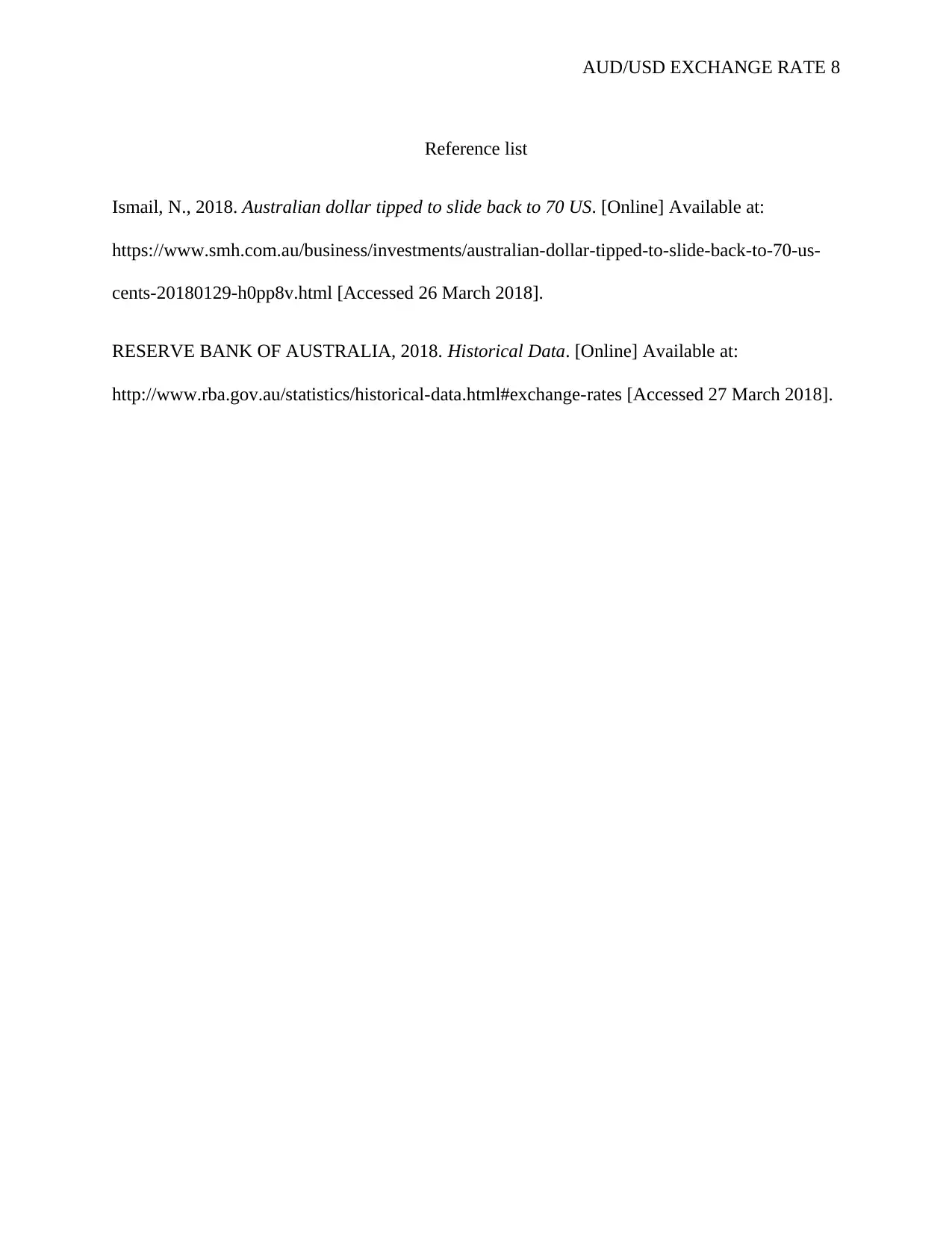
AUD/USD EXCHANGE RATE 8
Reference list
Ismail, N., 2018. Australian dollar tipped to slide back to 70 US. [Online] Available at:
https://www.smh.com.au/business/investments/australian-dollar-tipped-to-slide-back-to-70-us-
cents-20180129-h0pp8v.html [Accessed 26 March 2018].
RESERVE BANK OF AUSTRALIA, 2018. Historical Data. [Online] Available at:
http://www.rba.gov.au/statistics/historical-data.html#exchange-rates [Accessed 27 March 2018].
Reference list
Ismail, N., 2018. Australian dollar tipped to slide back to 70 US. [Online] Available at:
https://www.smh.com.au/business/investments/australian-dollar-tipped-to-slide-back-to-70-us-
cents-20180129-h0pp8v.html [Accessed 26 March 2018].
RESERVE BANK OF AUSTRALIA, 2018. Historical Data. [Online] Available at:
http://www.rba.gov.au/statistics/historical-data.html#exchange-rates [Accessed 27 March 2018].
1 out of 8
Related Documents
Your All-in-One AI-Powered Toolkit for Academic Success.
+13062052269
info@desklib.com
Available 24*7 on WhatsApp / Email
![[object Object]](/_next/static/media/star-bottom.7253800d.svg)
Unlock your academic potential
© 2024 | Zucol Services PVT LTD | All rights reserved.





